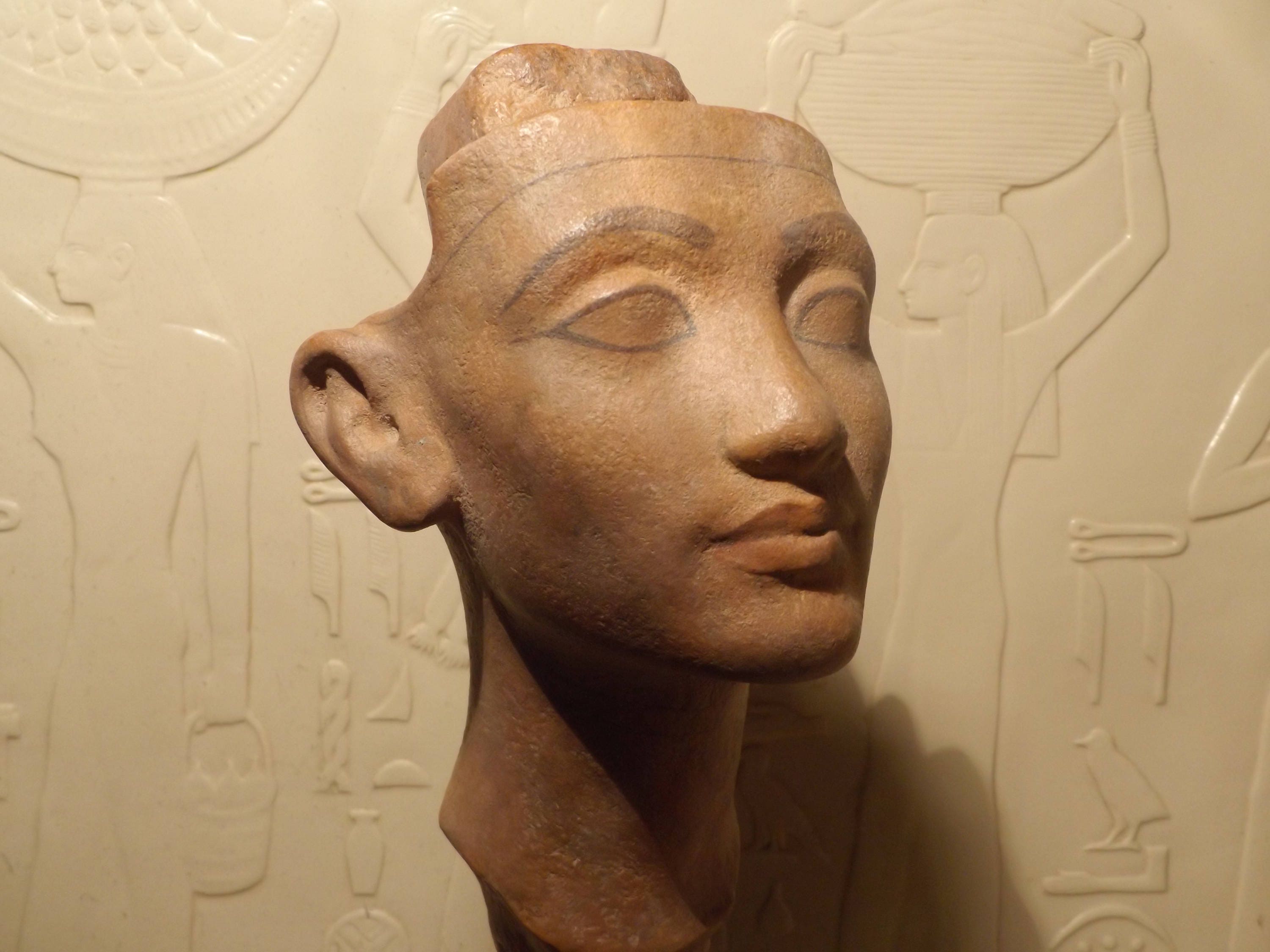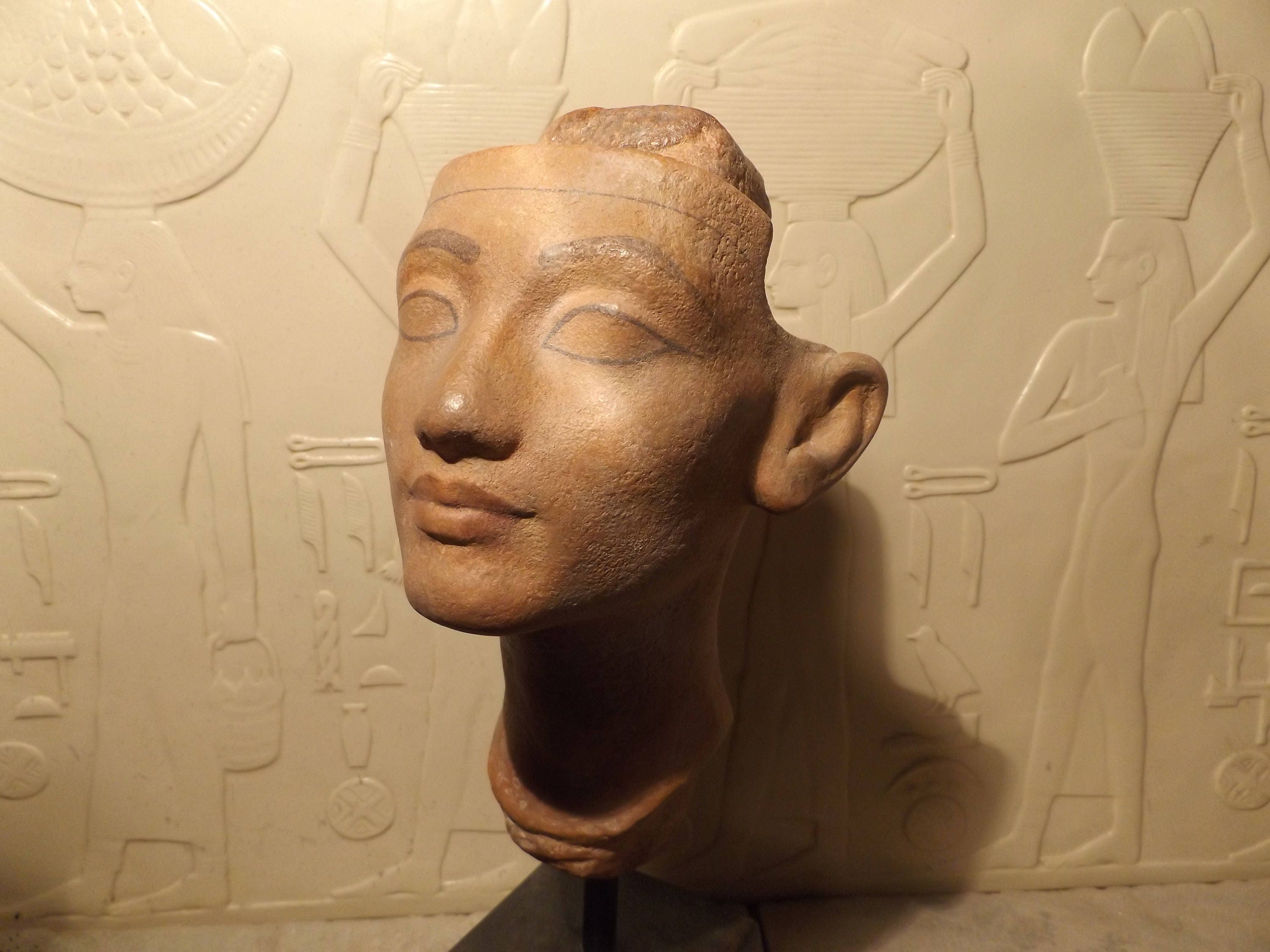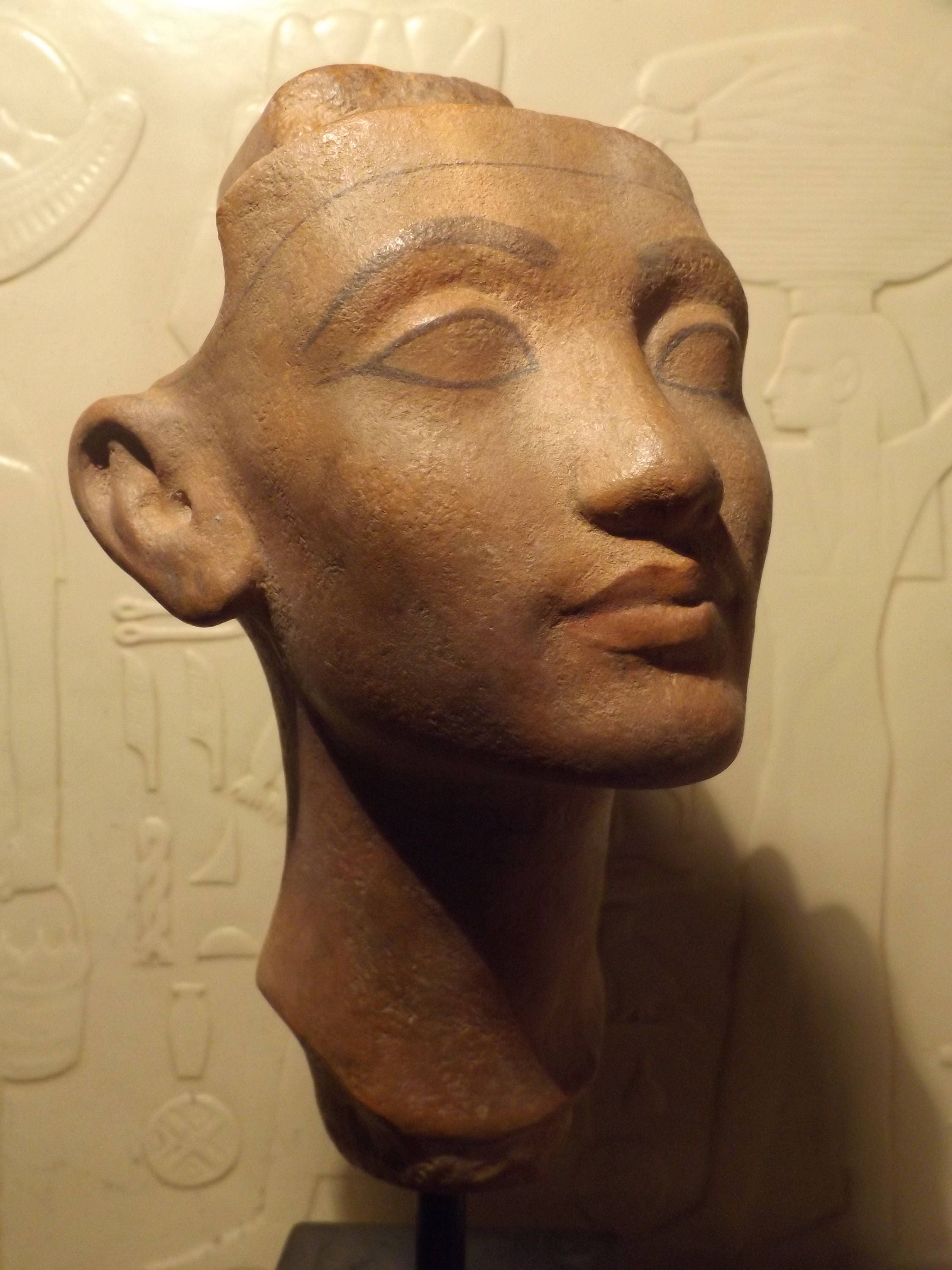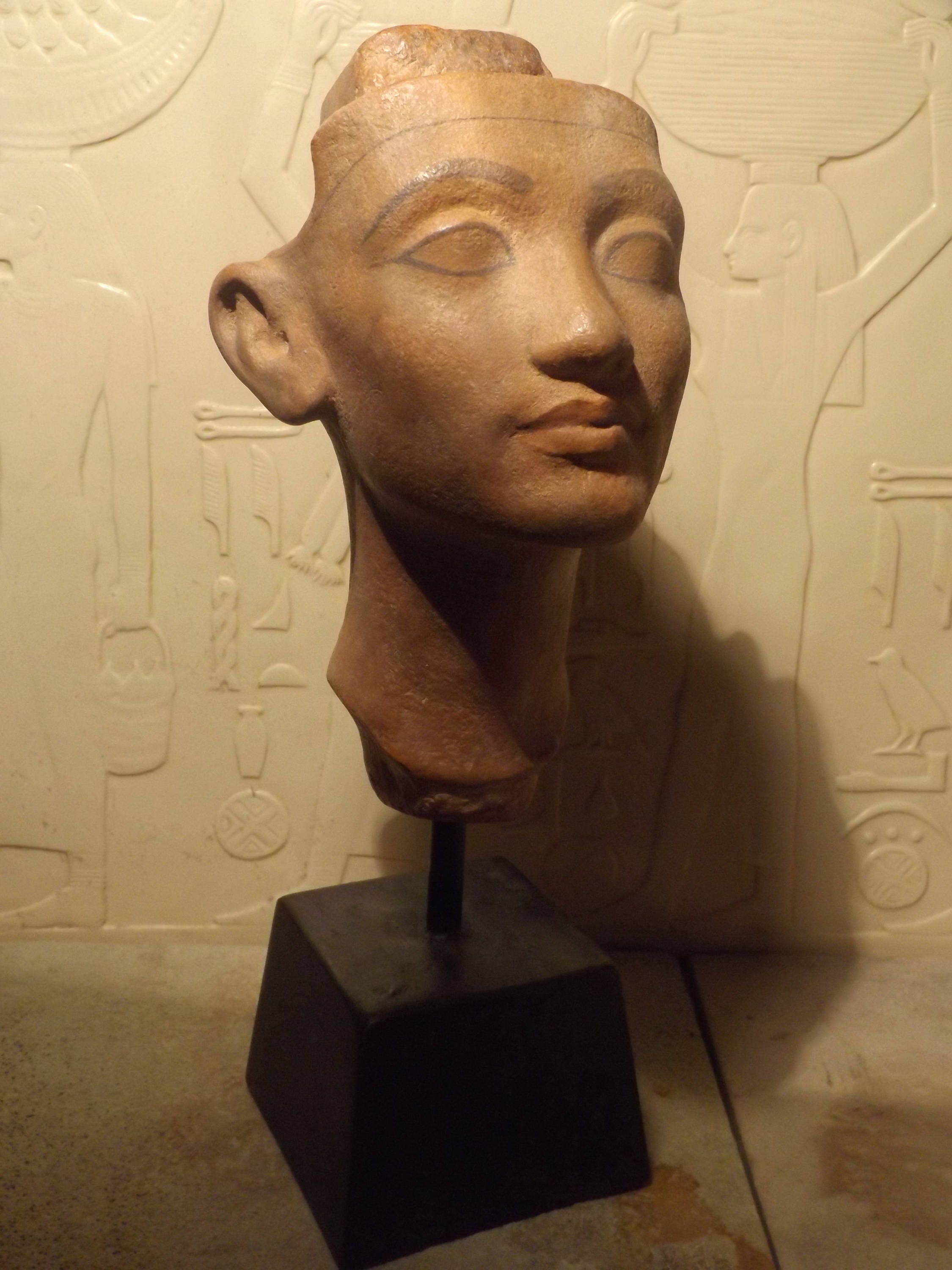Egyptian statue / sculpture Nefertiti-bust replica. Amarna period art
Queen Nefertiti
100th year anniversary edition of the original sculpture found in the workshop of the sculptor Thutmose at Amarna.
Dimensions :-
Height including stand - 39cm / 15-1/4 inches
Base stand - 12.5 cm x 12.5 cm / 5 x 5 inches
* A flat rate of shipping for international orders is shown and any excess postage paid will be refunded to you after postage.
Made of a limestone and quartzite composition stone it has an earthy ochre patina with a hint of red on the lips and black cosmetic details.
This is quite simply one of the most magnificent sculptures in my collection and I have decided to share this masterpiece in all its glory with my particular touches to emphasize realism. It is the closest thing you can get to owning the real thing unless you are planning to take the original housed in the Berlin museum.
This actual piece shown in the photographs, is a very fine copy of the original bust. It was found just over one hundred years ago in the ruins of the studio of the sculptor Thutmose at Amarna. It was during the 1912 excavation season at Amarna when she was first revealed but this discovery was to be only one of a great number of masterpieces found there including the famous bust of Nefertiti with tall blue crown.
It really is very close to me this story as I have always bowed to the mastery of my favourite fellow ancient sculptor. Bek was the other sculptor who had great work created in this city.
This bust is one of half a dozen or so of the famous Queen that were sitting on a shelf that collapsed in antiquity. They all fell into the sand that had already blown into the studio of the abandoned city of Akhetaton and were completely buried in a season or two, hence the terrific preservation.
Amongst these statues and found near to this one was the most famous one of all. The Nefertiti with the tall blue crown and a missing eye. One of the top 5 most famous images from the Egyptian civilisation.
This bust on offer is one of Thutmose's trial models for a composite statue type that became the fashion for the era and immediately after. Someone who was accomplished at making portrait heads did those while somebody that specialized making a torso or a hand produced that component. Of course Thutmose did most of the work and lavished the most attention on the beautiful faces of this haunting beauty.
The reason I like this one so much is that it is a lesson in subtlety. It has such grace in its uncompleted form with the eyes just sketched out and a rose red added to the lips.
The nob / tenon or tang on the top of the portrait was designed to join with a separate crown fixture and this is the case with many similar portraits discovered there. This is a solid reproduction from my master print that was made from the original last century and it is not a plaster cast or made with resin. The original was made in a quartzite sandstone which I have recreated as best I can which gives the natural look. The polished black stand is also hand made and is a truncated pyramid variety that compliments the piece very well.
It is my favourite piece in the collection of real and master copies and I never tire of looking at her. You will understand the subtle nature when she is in the room. She draws you in until you can't get any work done.
Essential history - Queen Nefertiti, her name translates… "the beautiful one has come". Any one who is even vaguely familiar with the artwork of ancient Egypt knows the image of Nefertiti. Her unique and distinctive crown towers above the timeless, regal beauty of her face. Her most famous portrait was discovered by German archaeologists in 1912 found face down buried in the studio of the sculptor Thutmose. The portrait bust is hailed as a masterpiece of world art but is only one of many depictions of the queen that were created in the city. Statuary, painting and in particular relief carving documented the life and style of this unprecedented era in Egyptian history.
Nefertiti and her husband, king Akhenaton were at the core of a religious and artistic revolution. Throughout the country the foundations of a belief system that had been ingrained into the consciousness of every Egyptian for over a thousand years was wiped out. Up until this time Egyptians were free to worship a multitude of elemental and mythical gods and goddesses that represented diverse attributes of nature and man. Gods of Wind, storms, music and dance, hunting and love, chaos and harmony all had their own unique iconography. The supreme god of the time was Amun "the hidden one" whose wealth and power were presided over by his influential priesthood. The priests of Amun became very wealthy and must have challenged the power wielded by the pharaoh in affairs of state. There is evidence to suggest this dating back to Akhenatons father, the third Amunhotep who began to have his own image carved under the rays of the new solar deity in defiance of the established priesthood. Some Scholars are almost certain that a co-regency existed between the King Amunhotep and his son towards the later years of his reign inspiring the ultimate break in convention. Akhenaton was originally named Amunhotep the fourth. However, during the fourth year of his own reign he changed his name, closed the temples of Amun across the land and abroad, moved the capital city several hundred miles downstream and built an entirely new city with a new culture on virgin soil.
Most Egyptians could not grasp the concept of one god and in Egypt's many cities and towns the population clung to their beliefs even though it was now forbidden to do so. For those of the population who were faithful to the king's new religion, an era of sumptuous decadence prevailed. The artistic achievements during this time display a relative freedom from the constraints of style that had been in place before the pyramids were built. Early portraiture of the royal family, who were central to the cult of the Aton, bordered on caricature, softening as the years progressed into some of the best examples of ancient art ever created.
Gone were the images of pharaoh smiting his enemy with a club or bow and arrow. In their place pharaoh nurses and kisses his wife and children, he leisurely rides in a chariot with his queen…royal tassels flapping in the breeze, feasting and solar worship are everywhere. A delicate observation of nature in all its Egyptian abundance translates not only in the imagery of artworks but a poem attributed to Akhenaton himself. Called the "hymn to the Aton" this body of words paints quite a romantic picture of the natural rhythms of the land. It must have been an exciting time to be alive in this new city with Egypt still at the zenith of its power and influence over Middle Eastern and Mediterranean cultures. One can imagine the harbour of the city bustling with the movement of foreign ships that had sailed for many months to bring trade and tribute to the revolutionary royal family and their subjects.
It was an era that eventually came to an end at the death of Akhenaton coupled with the growing dissension throughout the rest of the population who yearned for the old world order to return. The return to the worship of Amun and the rest of the pantheon of gods was imminent. The destruction that Akhenaton's city suffered was brutal. Within a short passage of time after his death, Akhenaton was classified as a heretic and all the temples, palaces and major buildings were torn down to the foundations. Statues and wall paintings were smashed and most of the cut and decorated stones were recycled into other buildings in other parts of Egypt. The whole site of Akhetaton was totally abandoned until just over two hundred years ago when a modern farmer stumbled across hundreds of clay tablets containing the correspondence issued in the time of Akhenaton. It was realized that this was the site of a buried city and here was the state archives.
Shipping from Australia
Processing time
1-3 business days
Estimated shipping times
- North America : 1 - 3 weeks
- Europe : 1 - 3 weeks
- Australia, New Zealand and Oceania : 1 - 2 weeks
- Asia Pacific : 1 - 3 weeks
- Latin America and the Caribbean : 1 - 3 weeks
- North Africa and the Middle East : 1 - 3 weeks
- Sub-Saharan Africa : 1 - 3 weeks
I'll do my best to meet these shipping estimates, but can't guarantee them. Actual delivery time will depend on the shipping method you choose.
Customs and import taxes
Buyers are responsible for any customs and import taxes that may apply. I'm not responsible for delays due to customs.
Payment Options
Returns & Exchanges
I gladly accept returns and cancellations
Just contact me within: 5 days of delivery
Ship items back to me within: 14 days of delivery
Conditions of return
Buyers are responsible for return shipping costs. If the item is not returned in its original condition, the buyer is responsible for any loss in value.





